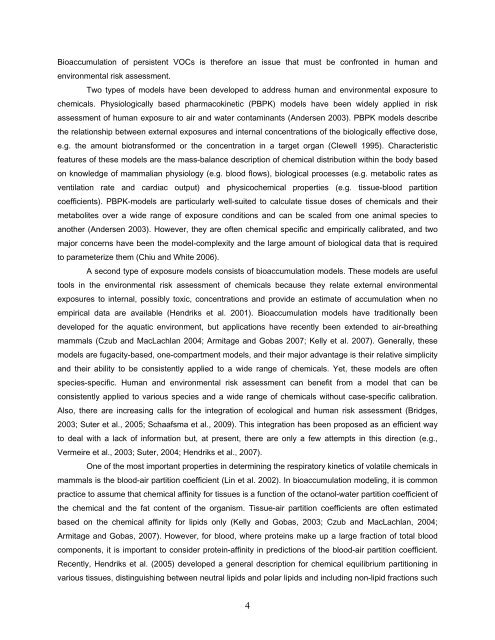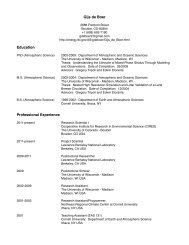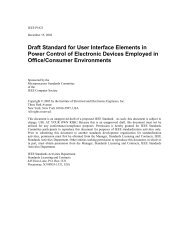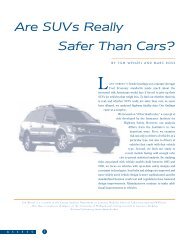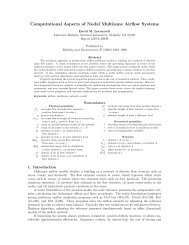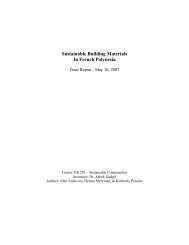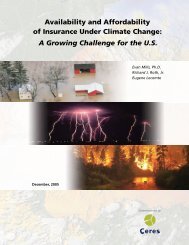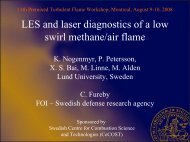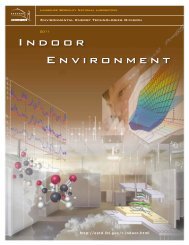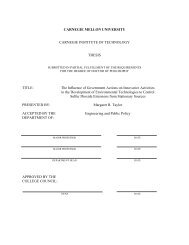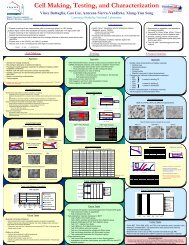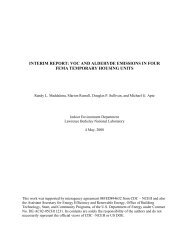Combining Biological Allometry, Chemical Equilibrium And ... - OSTI
Combining Biological Allometry, Chemical Equilibrium And ... - OSTI
Combining Biological Allometry, Chemical Equilibrium And ... - OSTI
Create successful ePaper yourself
Turn your PDF publications into a flip-book with our unique Google optimized e-Paper software.
Bioaccumulation of persistent VOCs is therefore an issue that must be confronted in human and<br />
environmental risk assessment.<br />
Two types of models have been developed to address human and environmental exposure to<br />
chemicals. Physiologically based pharmacokinetic (PBPK) models have been widely applied in risk<br />
assessment of human exposure to air and water contaminants (<strong>And</strong>ersen 2003). PBPK models describe<br />
the relationship between external exposures and internal concentrations of the biologically effective dose,<br />
e.g. the amount biotransformed or the concentration in a target organ (Clewell 1995). Characteristic<br />
features of these models are the mass-balance description of chemical distribution within the body based<br />
on knowledge of mammalian physiology (e.g. blood flows), biological processes (e.g. metabolic rates as<br />
ventilation rate and cardiac output) and physicochemical properties (e.g. tissue-blood partition<br />
coefficients). PBPK-models are particularly well-suited to calculate tissue doses of chemicals and their<br />
metabolites over a wide range of exposure conditions and can be scaled from one animal species to<br />
another (<strong>And</strong>ersen 2003). However, they are often chemical specific and empirically calibrated, and two<br />
major concerns have been the model-complexity and the large amount of biological data that is required<br />
to parameterize them (Chiu and White 2006).<br />
A second type of exposure models consists of bioaccumulation models. These models are useful<br />
tools in the environmental risk assessment of chemicals because they relate external environmental<br />
exposures to internal, possibly toxic, concentrations and provide an estimate of accumulation when no<br />
empirical data are available (Hendriks et al. 2001). Bioaccumulation models have traditionally been<br />
developed for the aquatic environment, but applications have recently been extended to air-breathing<br />
mammals (Czub and MacLachlan 2004; Armitage and Gobas 2007; Kelly et al. 2007). Generally, these<br />
models are fugacity-based, one-compartment models, and their major advantage is their relative simplicity<br />
and their ability to be consistently applied to a wide range of chemicals. Yet, these models are often<br />
species-specific. Human and environmental risk assessment can benefit from a model that can be<br />
consistently applied to various species and a wide range of chemicals without case-specific calibration.<br />
Also, there are increasing calls for the integration of ecological and human risk assessment (Bridges,<br />
2003; Suter et al., 2005; Schaafsma et al., 2009). This integration has been proposed as an efficient way<br />
to deal with a lack of information but, at present, there are only a few attempts in this direction (e.g.,<br />
Vermeire et al., 2003; Suter, 2004; Hendriks et al., 2007).<br />
One of the most important properties in determining the respiratory kinetics of volatile chemicals in<br />
mammals is the blood-air partition coefficient (Lin et al. 2002). In bioaccumulation modeling, it is common<br />
practice to assume that chemical affinity for tissues is a function of the octanol-water partition coefficient of<br />
the chemical and the fat content of the organism. Tissue-air partition coefficients are often estimated<br />
based on the chemical affinity for lipids only (Kelly and Gobas, 2003; Czub and MacLachlan, 2004;<br />
Armitage and Gobas, 2007). However, for blood, where proteins make up a large fraction of total blood<br />
components, it is important to consider protein-affinity in predictions of the blood-air partition coefficient.<br />
Recently, Hendriks et al. (2005) developed a general description for chemical equilibrium partitioning in<br />
various tissues, distinguishing between neutral lipids and polar lipids and including non-lipid fractions such<br />
4


